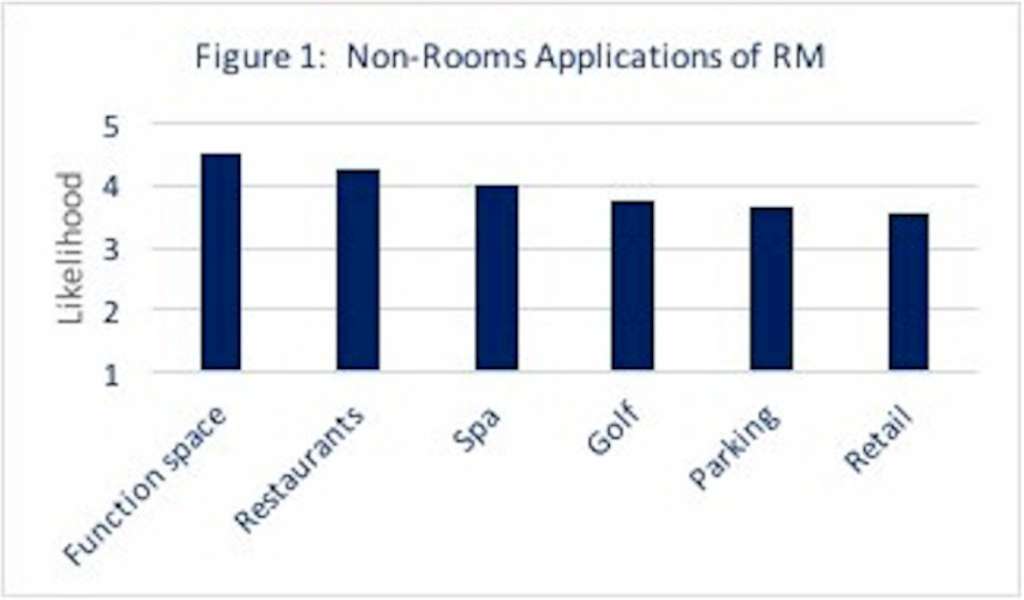
Revenue Management (RM) professionals have been talking about ‘Total Hotel RM’ (THRM) for well over a decade.
NB: This is an article by Sheryl Kimes, Professor Services Operations Management at Cornell University and Dave Roberts, Professor of Hospitality & Tourism Management at the Pamplin College of Business at Virginia Tech
In 2010, THRM was predicted to be implemented ‘within the next 5 years’ by a majority of survey respondents. In another study conducted in 2017, THRM was again identified as a significant future trend in RM, with function space, restaurants, spa, golf, parking, and retail all rated as ‘Likely’ or ‘Very Likely’ to see RM implementation (see Appendix I). There have been numerous articles and presentations at industry conferences, including some by both of these authors.
The application of RM principles to all revenue streams at a hotel makes intuitive sense, and the money at stake is enormous. And yet . . .
While some lodging companies, and some individual hotels, have made meaningful progress, we as an industry are not very good at this! More recent surveys confirm this. When asked how THRM was progressing on a scale of 1-5, the average rating was 3. Given the stakes, and the efforts/resources already invested, this suggests some significant impediments to progress. The purpose of this paper is to address some of these impediments and offer a few thoughts on how to proceed.
Possible Impediments
Alignment of Objectives:
This one sounds pretty straightforward, but it most certainly is not. For example, what is the objective of a hotel’s restaurant? To maximize profits? Maximize margin? Drive business to the hotel? Improve the overall hotel experience? Drive perception of the brand? These are all very different objectives, and they’d call for very different approaches and decisions. It is too easy to say ‘we have multiple objectives’. A balanced-scorecard type of approach is called for, with agreed-upon ‘weights’ and definitions of success. For example, would I rather increase my guest satisfaction scores, or my profit margin, by 2 points?
Margins:
If, for example, room revenue has an 85% profit margin, and non-room revenue has a profit margin of 25%, then the ‘business case’ to focus on non-room revenue, presumably with an opportunity cost, may be a tough sell. This, in combination with differing objectives, is one reason we as an industry have not made more progress. Any business case for THRM investment (more on this below) will need to address this, along with an unbiased estimate of our ability to actually drive profitability.
Data Quality & Availability:
In order to make progress, a common grounding in facts is required. Given the different systems involved and a historical lack of attention to the quality of the data these systems generate, this has proven to be a challenge. While decent data is available on room sales from a variety of PMSs and reservations systems, the same is not true for f&b outlets and spas. Tracking covers, ‘inquiries’, meal timing, and appointment requests has proven difficult, and synthesizing this data even for basic reporting remains a challenge in many cases. There is a bit of a ‘chicken/egg’ problem here too. We can’t do much analysis on spotty data, and we certainly can’t build a system, or even a very basic decision support engine, based on data with little credibility. On the other hand, investing time & energy into data quality clearly has a cost (including an opportunity cost), and the upside is tough to quantify without this analysis to support it.
Competing ‘Discipline’ Priorities:
Another very real impediment to progress is the fact that each department/discipline has plenty to work on already! For example, f&b departments are under significant pressure to continually elevate the guest experience while addressing escalating costs, including labor and technology. And despite significant progress in RM (authors’ bias noted), much work remains, even on some of the ‘basics’. Any attention given to THRM necessarily means less progress in these other areas.
Common Understanding:
It turns out that there is relatively little overlap between RM and F&B, for example, in terms of career paths. You tend not to meet a revenue leader who has worked in a restaurant, nor a restaurant manager with RM experience. Perhaps this is driven my different mindsets and backgrounds. There are exceptions of course, but the trend is clear. This makes it more difficult to think through potential approaches, even if there is alignment on objectives.
Possible Resistance to Change:
At some hotel chains that one of the authors has worked with (Marriott not being one of them!), some pushback from both f&b/spa managers and revenue leaders has been apparent. The f&b/spa managers sometimes view THRM initiatives as a threat and every once in awhile, revenue leaders prefer to stick with rooms RM rather than adding THRM to their portfolio. For an individual at some of these companies, addressing THRM directly can be perceived as a high-risk endeavor, with an unclear benefit.
Thoughts on How to Proceed
Given these very real impediments, we offer the following thoughts:
- Alignment on objectives is key. It may be that any significant undertaking in THRM should be initiated, and ‘owned’, by another discipline, such as finance, or planning (obviously depending on the structure of the organization). Discipline/function roles will need to be spelled out clearly, and senior management support is critical, including the approval to commit time and resources to THRM, and to say ‘no’ to some other competing initiatives. The ‘owner’ will need to develop a compelling business case to warrant any investment. Despite the fact that room revenue has a much higher profit margin, we as an industry are much further along with rooms RM; the marginal value of THRM may be more significant, and the business case will need to support this.
- Part of the business case must involve an investment (time and money) in data. Data quality/availability by itself offers no value – it enables value. The value, of course, is dependent on what is done with this data, and this will be different for each organization. We suggest thinking of data quality/availability as an ‘option’, not unlike a stock option, as it gives the opportunity for a future benefit. The benefit needs to go beyond reporting. Reporting is a good first step and can provide important grounding on some key metrics. That said, some decision support must be part of this case. We recommend aiming for decision support analytics, and getting comfortable with that, before thinking of any ‘system solution’.
- The business case will need to evaluate THRM in the broader context of the overall business. Is an investment in THRM a better use of resources than, say, an investment in mobile F&B or an investment in room upsells? Or more broadly, will an investment in THRM create more enterprise value than investments in the sales organization, marketing efforts, loyalty benefits, personalization, or the on-property guest experience? Without this context, THRM will remain a tough sell.
- Some of the practices we’ve observed that are effective in reducing possible resistance to change are building rapport between the revenue leaders and the F&B/spa leaders and attending the F&B/spa meetings to learn more about their operations and concerns. Once you’ve done this, another thing that we’ve seen that works well is to agree on one or two simple things that you’re pretty sure are going to work, and be sure to give the operational leader team credit for the success.
Summary and Conclusion
Why has the lodging industry not particularly good at implementing THRM? Revenue managers have been talking about THRM and its potential for years, but report that they have not made much progress. The question is why not? Essentially, some of the major impediments to progress are a misalignment of objectives, varying margins, data quality and availability, competing for ‘discipline’ priorities, the lack of common understanding and possible resistance to change.
Alignment on objectives is absolutely key to success as is building a solid business case. In the case of hotel companies that encounter resistance to THRM practices, we’ve seen that establishing rapport and celebrating the success of a few simple THRM initiatives goes far with reducing possible resistance.
In conclusion, we believe that hotel companies need to ‘own’ the THRM space, or else it will be owned by current and future disruptors and that owning this space necessitates understanding and addressing the very real THRM impediments we face.
Appendix I:
In a study on the future of hotel RM conducted in 2017, THRM was identified as something that would be a major trend in the future of hotel RM. Respondents were asked to assess the likelihood of RM implementation in different departments on a 1 (very unlikely) to 5 (very likely) scale. Departments considered to be the most likely were function space and restaurants followed by spas and golf. (See Figure 1).

Reprinted from the Hotel Business Review with permission from www.HotelExecutive.com




